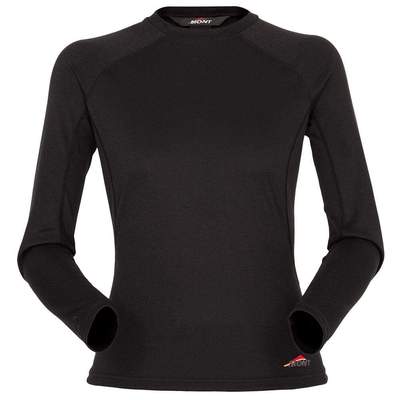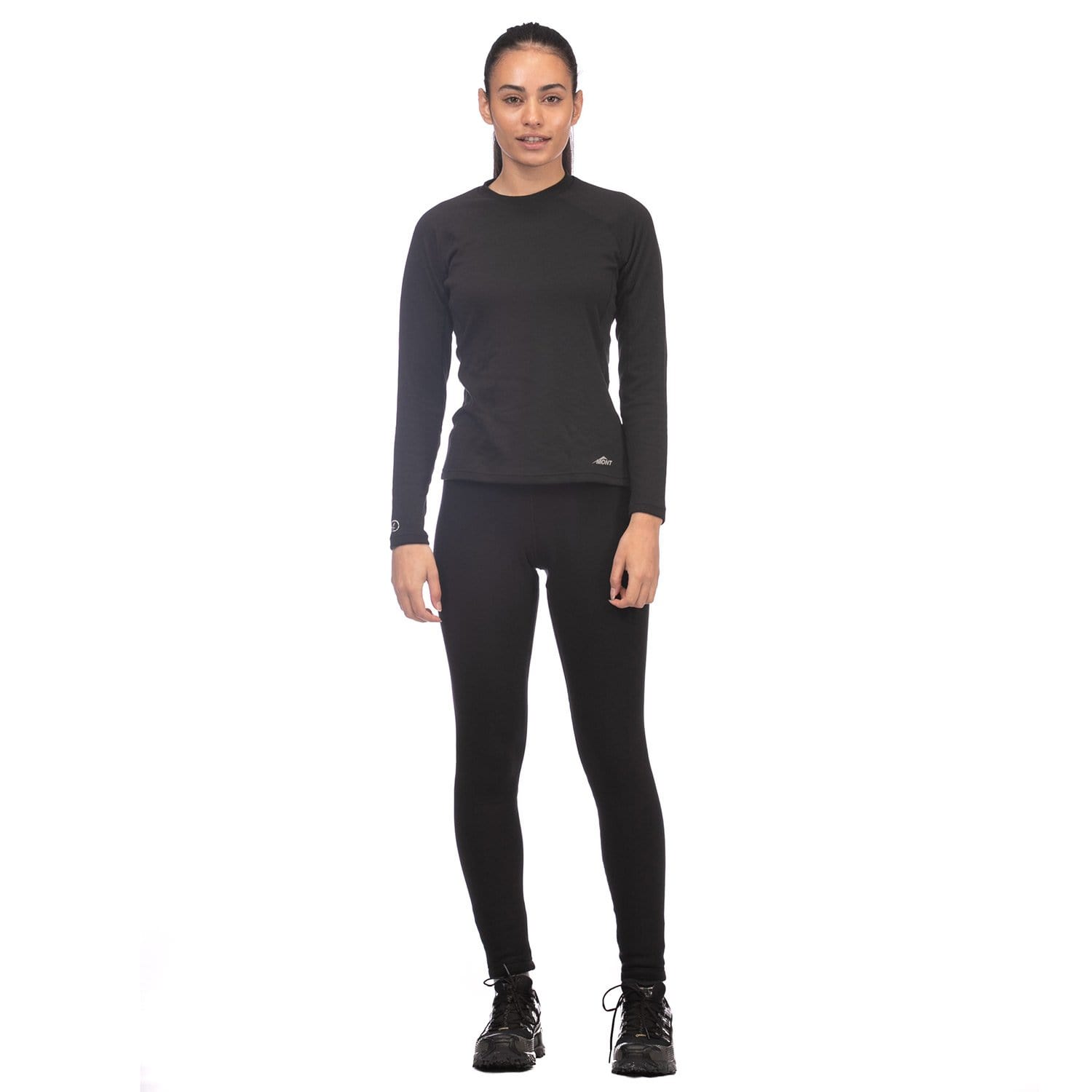Bust: Take measurement around the fullest part of the chest, just under the arms and across the shoulder blades.
Sleeve: With elbow bent, measure from centre back of neck (at C7 vertebra) to elbow and down to prominent outside wrist bone.
Waist: Measure around the smallest part of your waist (natural waistline).
Hips: Stand with feet together and measure largest circumference at hips.
Inseam: Measure a pair of well fitting pants from crotch to bottom of leg.
Next to Skin Fit: Designed to be worn next to skin. Body hugging fit for thermal and moisture management.
Active Fit: Trim fitting garments, ideal for active pursuits. Designed to fit over a base layer as required.
Regular Fit: A classic comfortable cut. Designed to fit over base and mid layers without restricting movement.
Relaxed Fit: A generous and relaxed fit. Cut loose enough for layering.
Measurements refer to body size not garment dimensions.
| Size (cm) |
8 |
10 |
12 |
14 |
16 |
18 |
| Bust |
82-85 |
87-90 |
92-96 |
98-103 |
105-111 |
114 |
| Sleeve |
75 |
77.5 |
80 |
82.5 |
85 |
88 |
| Waist |
68 |
73 |
78 |
84 |
92 |
102 |
| Hip |
90-93 |
95-98 |
100-103 |
105-110 |
112-118 |
122 |
| Inseam Leg |
78 |
80 |
82 |
84 |
85.5 |
85.5 |
Measurements refer to body size not garment dimensions.
| Size (cm) |
XS |
SM |
MD |
LG |
XL |
2XL |
3XL |
| Chest |
89-92 |
95-98 |
102-106 |
110-114 |
118-122 |
126-130 |
134 |
| Sleeve |
82 |
84 |
86 |
89 |
92 |
95 |
96 |
| Waist |
76 |
80 |
86 |
94 |
102 |
108 |
118 |
| Hip |
89 |
94 |
100 |
108 |
116 |
124 |
130 |
| Inseam Leg |
82 |
82 |
84 |
86 |
88 |
90 |
90 |
Measurements refer to body size not garment dimensions. Wearing ease alters depending on style and fabric.
| Size (cm) |
XS |
SM |
MD |
LG |
XL |
2XL |
3XL |
| Chest |
89-92 |
95-98 |
102-106 |
110-114 |
118-122 |
126-130 |
134 |
| Sleeve |
82 |
84 |
86 |
89 |
92 |
95 |
96 |
| Waist |
76 |
80 |
86 |
94 |
102 |
108 |
118 |
| Hip |
89 |
94 |
100 |
108 |
116 |
124 |
130 |
| Inseam Leg |
82 |
82 |
84 |
86 |
88 |
90 |
90 |
| Size (cm) |
3XS = 6 |
2XS = 8 |
XS = 10 |
| Chest |
77-80 |
83-86 |
89-92 |
| Sleeve |
78 |
80 |
82 |
| Waist |
68 |
72 |
76 |
| Hip |
77 |
83 |
89 |
Measurements refer to body size not backpack dimensions.
Measure from your C7 vertebrae down your spine to the point level with the top of your hipbones, the iliac crest. The C7 vertebrae is the one that sticks out prominently at the back of your neck when you tilt your head forward.
| Harness Size |
Extra Small |
Women's
/Small |
Medium |
Large |
| Back Length |
35-45cm |
40-50cm |
45-55cm |
50-60cm |
Using a combination of different layers is the best system for staying dry and keeping warm in winter, or comfortable in summer. Below is a simple guide to the different layers and garment types that can build a great layering system for a wide range of adventures.
Base layers and Next to Skin: This is your first layer and it should be a layer that wicks moisture away from the skin and drys quickly. Polartec Power Dry® garments are the perfect first layer, keeping you dry and comfortable in a wide range of conditions. We do not recommend merino as a base layer as it will absorb up to 30% of its weight in sweat, will become heavy and is very slow to dry.
Fleece & mid layers: A perfect second layer should be a warm, mid weight fleece garment or similar. Something with good stretch and moisture management is ideal.
Insulation layers: In colder conditions and for snow and alpine sports, a warm insulation layer is a great idea. Depending on conditions and how much you feel the cold, consider another fleece layer or a synthetic or down insulated garment. Garments in this category may have a hood, and also be wind & water resistant to delay the need to put on your shell jacket in cold windy conditions. When purchasing insulation layers ensure the sizing and fit allows for a base layer and lightweight mid layer underneath.
Shell Jackets: This waterproof, windproof and breathable layer is your essential piece of gear. It will keep you dry when the heavens open up, or shield you from blizzards in alpine winter conditions. Wear it over a single layer in mild weather or layer up in extreme cold, this garment should always find a place in your backpack. When choosing a shell jacket for bushwalking, trekking, ski or alpine climbing always ensure the fit and sizing allows for a base layer and some mid layers underneath, this way you can use it on adventures all year round.
Insulated Shell & Belay Jackets: If you're heading to Antarctica or have an alpine climb in mind, then it is common to have a very warm insulated outer layer. You can wear it at a high camp or over your shell jacket and other layers whilst on a frigid belay or an unexpected bivy. This is a specialist piece of gear for those who feel the cold or are heading to the high mountains. Ensure the fit allows for multiple layers to be worn underneath.





